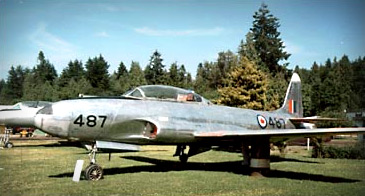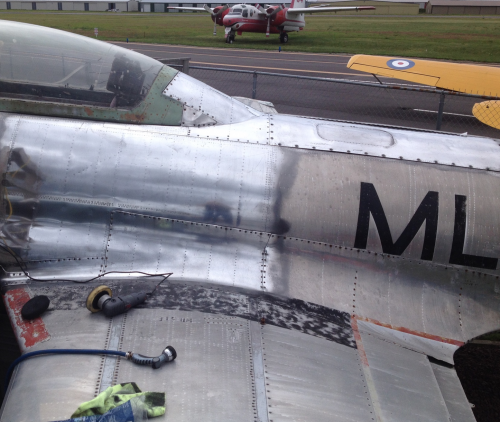
Canadair (Lockheed) T-33 Silver Star
A variant of Lockheed's F80 "Shooting Star" the T33A was the most widely used tandem two-seat advanced trainer in the world. The prototype flew for the first time on March 22, 1948.
The aircraft was supplied to the air arms of some twenty-five countries, and built under licence in Japan by Kawasaki, (210 machines) and in Canada by Canadair as the CL-30 Silver Star T-33AN, (656 examples). The Silver Star Mks. 2 and 3 differed from the U.S. manufactured T-33A in being powered by a Rolls-Royce Nene 10 turbojet. The parent company had manufactured a total of 5,691 T-33A and T-33B trainers when the last was delivered in August 1959.
Canadair was given a contract in September 1951 to manufacture the T-33 with the first flight being in December 1952. T-33's were used as trainers with the RCAF in the 1950's and 60's. Canada gave T-33s to Bolivia, France, Greece, Portugal and Turkey under the Mutual Aid programme.
RCAF 21487 was used at Gimli, Manitoba for RCAF and NATO pilot training until retired in 1967.
Donated to the Canadian Museum of Flight by Northwest Industries in 1977, with only 1067 hours total time, CMF's T33 lacks an engine, instruments and cockpit furnishings.
Technical Details:
Serial T33-487, RCAF 21487
Manufactured: 1955
Engine: 5,100 lb (2,315 kg) thrust Rolls-Royce Nene 10 turbojet
Maximum speed: Mach .787, 600 mph (960 km/h)
Empty weight: 8,440 lb (3,832 kg)
Loaded weight: 18,400 lb (8,217 kg)
Span: 37 ft 7 in (11.48 m) without tip tanks
Length: 37 ft 9 in (11.49 m)
Height: 11 ft 8 in (3.6 m)
Wing area: 238 sq ft (22.11 sq m)
Fun Facts:
Out T-33 is very unique, in that the guns ports are still uncovered. Very few T-33's are like this, most have the ports covered completely with a plate, so you don't know what's under there. Now you know!

T-33 Restoration.
One of the many ongoing projects at the Museum is to keep our display aircraft in good shape. Even if we believe they are not going airborne any time soon, they still need regular attention to their condition. The Canadair-built CL-30 Silver Star (Lockheed T-33) is undergoing a refresher at present. The aluminum exterior skin is being polished and the RCAF operational markings renewed. Then the whole aircraft will be clear coated to preserve the finish. On the agenda is the addition of the tip tanks - large capacity fuel tanks to extend the range of the aircraft. These are presently in storage as their size prevents them being fitted at the T-33's present location on the airside area of the Museum hangar. A further exciting possibility is the moving of the aircraft to the location of the new Museum facility on the south side of Langley airport accessible from the Fraser Highway.
Steady progress is being made on returning our ex-RCAF Silver Star (T-33) to near factory-new condition.
You will need your sunglasses to view the condition of the aircraft on sunny days...
The nose gleams.
This shot of work in progress on the fuselage...
...shows the contrast of the finished job. Work on the wings is now under way.
Need a project? Give Ron a hand with this amazing project.
**********
Museum volunteer, Ron, has the restoration project underway. Would you like to help?
Time, muscle power, attention to detail and a good pair of sunglasses are the requirements.
Of course, if none of the above are practical, a donation to the project would be very acceptable.
Call the Museum at 604-532-0035.






